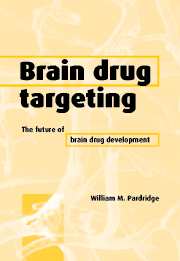Book contents
- Frontmatter
- Contents
- Preface
- List of abbreviations
- 1 Drug targeting, drug discovery, and brain drug development
- 2 Invasive brain drug delivery
- 3 Lipid-mediated transport and carrier-mediated transport of small molecules
- 4 Receptor-mediated transcytosis of peptides
- 5 Vector discovery: genetically engineered Trojan horses for drug targeting
- 6 Linker strategies: the engineering of multifunctional drug formulations
- 7 Protein neurotherapeutics and peptide radiopharmaceuticals
- 8 Antisense neurotherapeutics and imaging gene expression in vivo
- 9 Gene therapy of the brain
- 10 Blood–brain barrier genomics
- References
- Index
- Plate section
4 - Receptor-mediated transcytosis of peptides
Published online by Cambridge University Press: 08 January 2010
- Frontmatter
- Contents
- Preface
- List of abbreviations
- 1 Drug targeting, drug discovery, and brain drug development
- 2 Invasive brain drug delivery
- 3 Lipid-mediated transport and carrier-mediated transport of small molecules
- 4 Receptor-mediated transcytosis of peptides
- 5 Vector discovery: genetically engineered Trojan horses for drug targeting
- 6 Linker strategies: the engineering of multifunctional drug formulations
- 7 Protein neurotherapeutics and peptide radiopharmaceuticals
- 8 Antisense neurotherapeutics and imaging gene expression in vivo
- 9 Gene therapy of the brain
- 10 Blood–brain barrier genomics
- References
- Index
- Plate section
Summary
Introduction
Receptor-mediated transcytosis (RMT) systems exist at the blood–brain barrier (BBB) in parallel with the carrier-mediated transport (CMT) systems reviewed in Chapter 3. The CMT systems mediate the BBB transport of small molecule nutrients, vitamins, and hormones and operate on the order of milliseconds. In contrast, the RMT systems mediate the BBB transport of circulating peptides and plasma proteins such as transferrin (Tf), and operate on the order of minutes. The CMT systems are stereospecific pores fo med by transmembrane regions of the transporter protein that traverse the luminal or abluminal endothelial plasma membranes. In contrast, BBB receptors have relatively small transmembrane regions and large extracellular projecting portions that form the ligand-binding site. The receptor–ligand complex is endocytosed into the endothelial cell, packaged within an endosomal system, and traverses the endothelial cytoplasm for exocytosis in a matter of minutes. The distance that must be traversed in the process of transcytosis through the BBB is only 200–300 nm. This short distance may be the reason why BBB transcytosis is relatively rapid and occurs within minutes. There are numerous peptide receptor systems expressed at the BBB, and many of these mediate the RMT of the circulating peptide through the BBB (Figure 4.1).
The capillary endothelial barrier of the vertebrate brain is unique with respect to other endothelial barriers in peripheral tissues.
- Type
- Chapter
- Information
- Brain Drug TargetingThe Future of Brain Drug Development, pp. 82 - 125Publisher: Cambridge University PressPrint publication year: 2001
- 2
- Cited by



